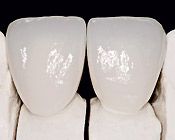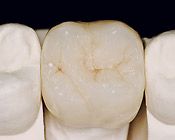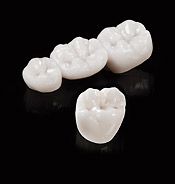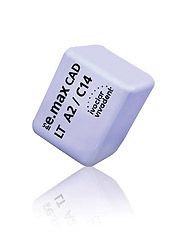Materials: Science Vs. Gut
Flip through the pages of an issue of Dental Lab Products or walk a tradeshow floor, and you’re likely to cross paths with at least one new material. Keeping up with the stream of new options for your lab can be almost dizzying.
Flip through the pages of an issue of Dental Lab Products or walk a tradeshow floor, and you’re likely to cross paths with at least one new material. Keeping up with the stream of new options for your lab can be almost dizzying.
Some new materials are breakthroughs requiring new categories and opening new technical approaches, others are simply expanded shade options for an established line. But whether it’s a new ceramic system, alloy or millable block, watching these developments and correctly assessing which ones can improve processes and outcomes at your lab is an important part of staying successful.
Tracking all these developments can almost seem like a full-time job. But it’s a job that pays off when your lab knows just the right time to begin offering restorations made from the latest materials that produce higher quality and more efficient results.
“I think more and more now with the technology advancements, it’s not like a new thing comes out once a year and it’s small. Now, we regularly have major innovations,” said Gary Iocco, President of Dimension Dental Design in Hastings, Minn.
Attractive qualities
As he evaluates the new developments on the materials market, Iocco is looking for options that offer higher-quality outcomes, but many other factors come into play before something piques his interest. A quality material option may be too much trouble if incorporating it calls for entirely new workflows or expensive equipment investments. Then again, he said there are times when the benefits of new innovations can be substantial enough to make such investments worthwhile.
Strength and esthetics are the first qualities to be assessed when Bob Ziemek, owner of Ziemek Aesthetic Dental Lab in Olympia, Wash., is looking at new product and material options. His lab tries to stay on the leading edge of the industry, but he still looks carefully at new materials and prefers options that don’t require his dentists to drastically change the way they prep and seat restorations. When it comes down to it, Ziemek said he always approaches new materials asking the question, “Is it going to last a long time?”
Staying in front of the industry curve is imperative for the business model of Precision Ceramics Dental Laboratory in Montclair, Calif. Co-Owner/Vice President Mark Jackson, RDT, is always on the lookout for something that will not only improve on the existing options his lab can produce but also will be attractive to both existing and new dental accounts.
Dentists need to trust and be comfortable with a new material, and many big successes are simple, but significant improvements on another popular material. Jackson said a perfect example of this is Glidewell Laboratories’ BruxZir full-contour zirconia, which as a monolithic material eliminates the problems of veneering porcelains chipping off zirconia substructures.
“I look at this as being a product that is perfectly placed to be successful because it addressed all of the shortcomings of other popular products on the market at the time,” he said.
It’s also a new material Iocco cited as a great fit and a big winner for his lab, but for him the attractiveness of BruxZir was as much about the company behind the material as it is about the material’s qualities. Iocco said his lab places a lot of faith in a company’s track record of launching quality products. He also appreciates when companies provide marketing support, because his lab doesn’t have a large marketing budget. In fact, he said when companies such as Glidewell or Ivoclar Vivadent aggressively and successfully market their latest offering to both the clinical and lab sides of the industry it creates momentum that makes it difficult to avoid implementing their latest material developments.
“If our doctors see things, and if it will work better for them, we want to be able to provide that. If we don’t do it, someone else will,” Iocco said.
Driven by data
But evaluating new material options is certainly about much more than just hopping onto the bandwagon of a successful mass-marketing effort. Jackson said materials development really is about the science underlying the material’s physical properties. The more novel the material, the more of that research and success in pre-clinical trials he wants to see before being ready to take it and run.
Both Ziemek and Iocco agree that seeing published research is a key factor when evaluating a new material. Seeing long-term studies showing success in patients’ mouths can be powerful evidence in favor of something new. Still, Ziemek said finding time for this is a difficult necessity.
“Things are changing so rapidly that you almost have to have people involved in researching these developments,” he said. “For a small lab, it’s tough.”
For Jackson, watching the latest developments in materials science is both a passion and a key part of his role at Precision Ceramics. At CE events, Jackson spends all his time in the materials science sessions rather than the technique-focused courses. He also reads journals and stays involved with online forums for the dental technology industry, but also for the engineering and medical device industries, because Jackson believes that much like with zirconia and titanium, the next wave of materials to shake up the dental world are already being developed and used in other industries.
“This is a cottage industry, and we get trickle-down technology,” he said. “I can tell you with a high degree of confidence that the next generations of materials are going to be resins, and some of that technology is going to be coming from medical and defense industries.”
All of this research is crucial because Jackson wants to keep himself and his lab from being caught by surprise when new developments arrive. Still, even if he is familiar with their uses in other industries, when materials are launched for dental use, Jackson approaches with caution because he can recall a number of times he jumped into something new only to get caught up in unexpected failures.
Failures of new materials usually are not because of problems with the material’s physical properties, as much as how those properties get adapted to dental purposes. This is why Jackson’s evaluation process takes more than just the material itself into account. For him to be sold on something new, the entire system of working with it from the lab’s processes to the way it will be seated in the patient’s mouth needs to be backed by sound evidence.
“When I evaluate something new, I look at what other materials are going to be used with it to see if this is going to be some sort of cohesive system,” he said. “I keep up with this stuff because I have to. I’ve still got another 25 years in this industry. I have to constantly stay a step ahead and keep my eyes on the horizon.”
Making a match


Designed for efficiency with just one porcelain and one ingot, DENTSPLY Ceramco’s Ceramco iC system can be used for a range of restorations and combination cases.
Photos courtesy of DENTSPLY Ceramco
Staying on top of the latest research and development news is an important part of the process, but knowing your lab internally is just as important. It is that knowledge that will tell you when a material is not just a fit for the industry, but a winning addition to your lab. Jackson said having a clear vision for his lab is really the first step of evaluating new materials.
“In choosing new products and materials, I can never lose site of the direction we’re headed and take little side trips,” he said. “I need to look at the long term objective and make sure every new product and everything we do is headed in that direction.”
For Precision Ceramics that direction is all-digital design without a physical model and automated production out of monolithic materials. When a product fits into this workflow and comes with an easy-to-identify client base, Jackson gets excited.
“If those two things come together and match up, then that tells me, yeah, ding-ding-ding, this product is a winner,” he said.
For Iocco and Dimension, figuring out when a new product is a match for his lab involves assessing the general dental lab marketplace. When new options match up with his existing technology and workflows, the transition is easier, but he’s always trying to proceed with caution to be sure he doesn’t go full speed with something that doesn’t pan out six months later.
It’s a balancing act because waiting too long to launch a product can mean losing accounts to other labs providing it earlier. Iocco said he likes to at least have things in an internal testing phase so he can be ready to launch when he sees indications the market is ready.
“We’ve been burned on a couple products over the last 20 years, so I don’t like to be the first lab to have a product. But you don’t want to be the last guy on the bus because by then the bus is already full,” he said. “When we hear a couple of our doctors ask us about something, we know it’s time to introduce it.”
Being ready to go with that new material can be fairly simple, or it can require an overhaul of the lab’s production process. When he added Ivoclar Vivadent’s e.max lithium disilicate it was simple because it fit with his lab’s milling and pressing workflows, but Iocco said regardless of how smooth the transition will be, he still needs to have his technicians on board with the change early in the process. He starts building staff buy-in as soon as he identifies a potential new product for the lab.
“If it’s something that’s going to give us a better product, save us time and make us more profitable, then we’ll bring a rep in and have the rep talk to our staff,” Iocco said.
Being in regular contact and having a good relationship with the material manufacturers helps Ziemek when he is adding the new products as well. Having a level of trust in that relationship means you are confident that when a company tells you something will work, it will work, and when they train technicians on proper use of the new product, the lab will be ready to work with it correctly.
Trusting the techniques
Manufacturer training followed by first-hand experience is extremely important to evaluating a new material. But that hands-on experience working with the new material has to be about mastering the steps taught by the manufacturer and figuring out if those processes work for you.
Ziemek said the companies producing the materials have really done the R&D homework and when there are problems with the end result, it is usually because the lab was not following instructions. Iocco added that working with trusted manufacturers helps inspire confidence and speed up the process of moving from one generation of materials to the latest development.
“You always hear of some dental technicians who shortcut things. You can’t do that. What makes us think that we can shortcut it and still have the material react the same way?” Iocco said. “If you use the manufacturer’s recommendation, it usually works out fine. Then it’s just fine tuning it for our esthetics and how we work it into our workflow at our lab.”
Jackson also comes down firmly against deviating from the manufacturer’s recommended processes and protocols. He said it is important to work with one entire product system because that manufacturer has done its research and trials with those components working together. His view is that mixing elements from one company’s system with those from another for use on a case to be seated in a patient’s mouth is an experiment with that patient as an unknowing subject. Jackson and his lab are not willing to go that far to get satisfactory results.
“There’s no room for gut instinct any more. What we do is evidence-based,” Jackson said. “If we find a product, I don’t care if it’s really popular and everybody does it, if it doesn’t work for us without being bastardized or adulterated, then it’s just not a good fit for my lab. When I’m working on actual cases to go in a human’s mouth, I’m not going to find any new tricky techniques because I’m not trying to.”
He does participate in beta tests, and those are the times he tests different firing protocols or looks for ways to achieve greater efficiencies and higher-quality outcomes. However, when a case is destined for a patient’s mouth, everything is done by the book. Jackson said using a company’s material puts a lab into a partnership of sorts with that company and links their professional reputations to the restoration’s success.
Teaming up

Photo courtesy of Glidewell Laboratories
Of course in today’s dental landscape, those partnerships forged over materials go beyond just the ties between labs and the companies developing the materials the labs use. Outsourcing production of copings, bars, frameworks and entire restorations is now common, and smaller labs are able to take advantage of these opportunities to expand the material options they can offer their dentists.
Iocco said the ability to tap into milling centers and outsource labs is a way for smaller labs to build business around a new material without investing in new equipment. His lab only made the investment in their own mill after generating a steady flow of porcelain fused to zirconia crowns. With the business in place, his investment in a mill was offset by being able to cut his monthly outsource bill.
Preparing for launch
Moving to in-house zirconia production went smoothly for Iocco because his technicians already knew how to finish the milled copings. There still was a learning curve as his technicians mastered running the mill, but Iocco said this was no different than working out the kinks of any new product.
Using a new material is the only way to overcome this learning curve. When Ziemek’s lab is mastering a new material he doesn’t like to put a set timeframe on the process. Doing that could mean sacrificing in quality, which is not fair to the dentist or patient receiving the restoration.
Confidence that the new product will offer some advantage over what the lab currently works with is necessary to making the internal testing process worthwhile, Iocco said. Confidence also comes into play when figuring out exactly when demand exists and it’s time to launch the new product.
“That’s the gut part of materials,” Iocco said. “That end of it-when we put it out there-you don’t want to be too soon, and we want to make sure we know what we’re doing here.”
Jackson knows when his lab is ready to green light something new because the lab follows good manufacturing practices (GMPs) with detailed quality control programs that allow him to track every step of every restoration making its way through the lab, identify problems and trace their sources, whether it’s a bad batch from a manufacturer or a flaw in the workflow.
He has assurances of the training of his staff, the calibration of his equipment and that all of the procedures are documented. As long as things are done properly, anomalies are easy to spot, as are new products that aren’t performing as expected. Jackson said he was spurred to enact such rigorous recordkeeping after experiencing product failures in the past. While they now help him spot new products that aren’t going to work for his lab, they also taught him the importance of the manufacturer-recommended protocols.
“Our GMPs here give me a lot more confidence when launching new products,” he said. “Once I had good manufacturing practices in place, all of my product failures and product problems basically went away, which tells me a lot of them originated right here in my lab.”


Photos courtesy of Ivoclar Vivadent
Building new business
Once a lab has worked out the kinks and built up confidence in efficiently achieving quality with a new material, it still needs dentists interested in prescribing those restorations. Lower-cost options are always a good selling point, Ziemek said, but the best way to effectively launch something new comes from working closely with the dentists sending cases to his lab.
While testing a new material, Ziemek reaches out to a handful of dentists to find cases that can be completed and seated before the lab is ready to offer the new material to everyone. Working with dentists this way builds trust on both sides and allows his lab to train the dentists a bit when new materials require specific preparations to work effectively.
Iocco works with dentists in a similar way and offers different dentists early access to different products so everyone working with his lab feels valued and has a chance to get in early on his next big thing. Still before bringing dentists into the equation, Iocco needs to have complete confidence in his new products so he is not sending out a case he considers to be a test.
“Our doctors rely on us, and they trust us. We have to be very careful not to abuse their trust,” he said.
Not every new product works as well as he would like, but Iocco said the materials being developed are exciting, and he plans to continue putting his lab in a position to work with the best options available.
“Our industry has changed so much in the last 10 years,” he said. “I can’t wait to see what happens in the next 10 years.”